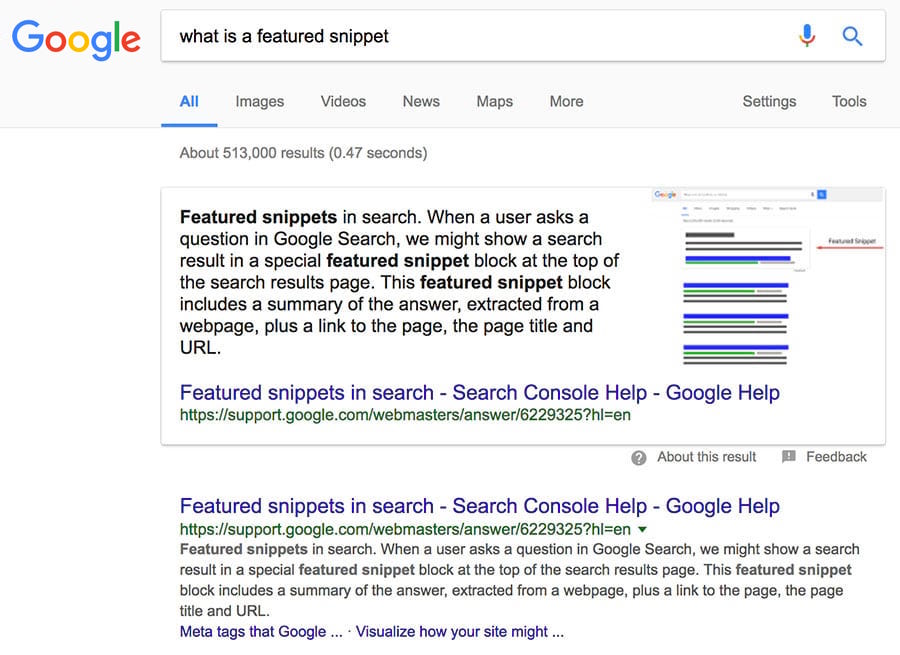Google Snippets Part 1: How do snippets impact search behavior?
This is the first part of our blog series about google snippets. If you want to know how snippets impact search behavior continue reading…if you want to learn how to grab that top spot, check out Google Snippets part 2.
Google constantly tweaks its search algorithms and how they present the search results. One of the features that users have been seeing a lot more of recently is Google Snippets. Let’s look at how Google snippets impact user behavior and SEO strategy for B2B brands.
But first… what are Google snippets?
You have probably utilized Google snippets in your day to day search activity even if you don’t realize it. They are the two to three sentences that appear in a box at the top of the page that appear when you complete a search. Usually (but not always) these sentences are pulled from the #1 or #2 search results. Here is an example of a Google snippet…it’s about Google Snippets:
How do Google snippets impact search behavior?
Everyone takes advantage of Google snippets. Think about it, if you Google a question and receive an answer right on the search results page, why would you click through to another page? Google wants to provide the best user experience (UX) possible. They want to serve their customers’ quick answers and continue to dominate the search market.
The new Google UX is changing how people interact with web content.
This new UX is having a big impact on search behavior. A comprehensive survey by Ahrefs found the following:
- Searches using snippets: Looking at two million different keywords, 12.3% of queries have snippets, although this number is expected to increase as Google continues modifying its algorithm.
- Traffic: When there was no featured snippet on a page the top result received about 26% of traffic. In contrast, when a featured snippet was present the top result received less than 20% of traffic, while the features snippet grabbed about 8.6% of traffic.
- Clicking behavior: The survey found that total click-throughs for all results were 5% lower when a snippet was present than when there was no snippet shown.
- Rank: Most (but not all) snippets come from the top-ranked result and 99.58% are at least from the first page of results. The tiny 0.42% of snippets that are not from the first page of results include additional formatting like answer boxes, which help them snag that coveted spot.
What does this mean for SEO?
Many people fear that featured Google snippets will have negative impacts on all of their SEO efforts, but here are some things to remember:
 Not Your Target Audience
Not Your Target Audience
Although snippets can negatively impact traffic to your content, that lost traffic likely wasn’t your target audience. Users who are satisfied with a snippet are just looking for a quick answer to a question. If they click through to your page, they are unlikely to meaningfully engage with your content anyway. Less traffic perhaps – but most of that was junk traffic for B2B marketers.
 Increased Brand Visibility
Increased Brand Visibility
If you are lucky enough to snag the snippet you can significantly increase your brand visibility. This exposure increases familiarity and trust for your company, so when someone comes back to look for a product you offer they are likely to gravitate towards your solution instead of a competitor.
 Google Snippet Optimization
Google Snippet Optimization
Like all SEO, you can optimize your content for Google snippets. Read our other blog post on Google snippets to learn the best formatting and content optimization strategies to get that spot. Also, keep in mind while 12.3% of keywords do have featured Google snippets, 87.7% of keywords don’t. Continue focusing on your normal SEO efforts to increase organic traffic.
SEO is Always Changing
Remember that search algorithms are always changing. While Google snippets are relevant today, everything could change again tomorrow.
Remember, search algorithms are always changing, which means SEO strategies are constantly changing too.
Basing your SEO strategy on the latest iteration of another company’s search algorithm is a fool’s errand. The big picture is that search engines are trying to replicate a human’s judgment on what is relevant and useful. And they’re rapidly getting better at it. To be successful, you must maintain a long-term focus on being relevant, useful, and clear about whatever keywords you’re trying to address on any given page or blog post.
- Medical Marketing SEO: Using SEO to Target Doctors and Healthcare Professionals (+ Checklist) - December 4, 2023
- Marketing to Dentists: How to Market to Dentists - August 8, 2023
- HCP Marketing Trends 2023: 23 HCP Marketing Stats for 2023 - November 30, 2022







